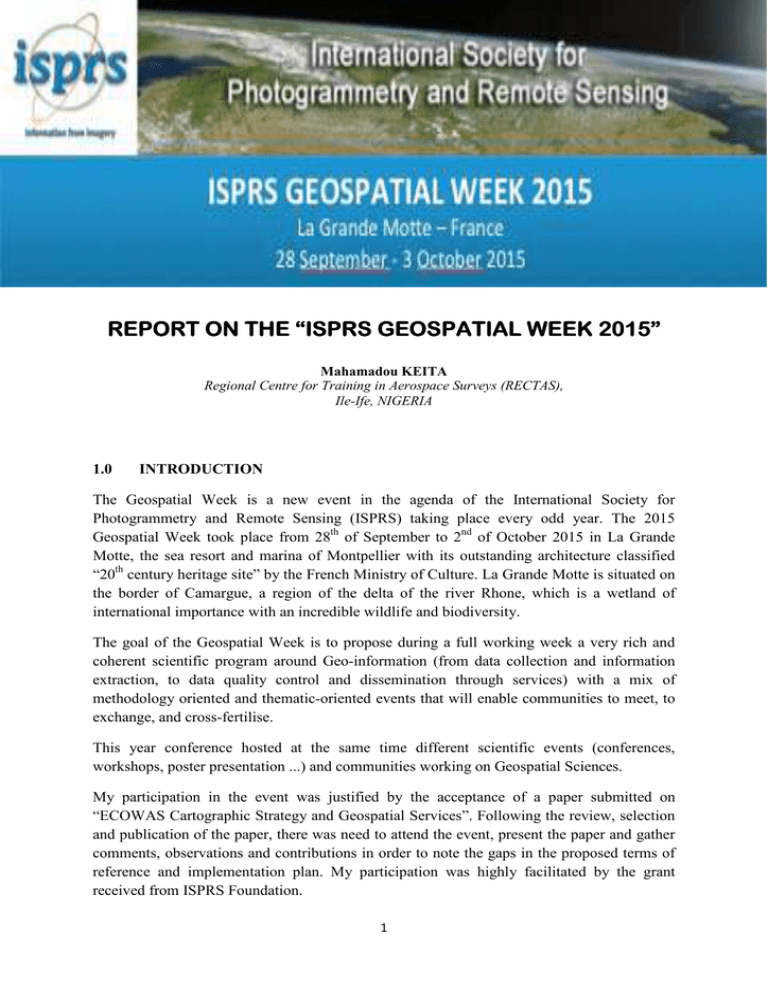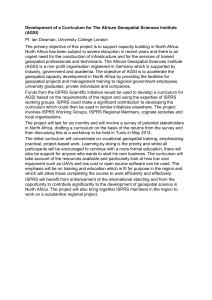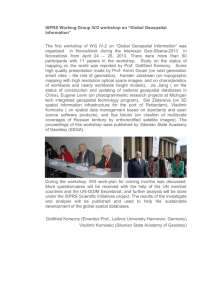REPORT ON THE REPORT ON THE “I “IS SPRS GEOSPATIAL WEEK 2015”
advertisement

REPORT ON THE “IS “ISPRS GEOSPATIAL WEEK 2015” Mahamadou KEITA Regional Centre for Training in Aerospace Surveys (RECTAS), Ile-Ife, NIGERIA 1.0 INTRODUCTION The Geospatial Week is a new event in the agenda of the International Society for Photogrammetry and Remote Sensing (ISPRS) taking place every odd year. The 2015 Geospatial Week took place from 28th of September to 2nd of October 2015 in La Grande Motte, the sea resort and marina of Montpellier with its outstanding architecture classified “20th century heritage site” by the French Ministry of Culture. La Grande Motte is situated on the border of Camargue, a region of the delta of the river Rhone, which is a wetland of international importance with an incredible wildlife and biodiversity. The goal of the Geospatial Week is to propose during a full working week a very rich and coherent scientific program around Geo-information (from data collection and information extraction, to data quality control and dissemination through services) with a mix of methodology oriented and thematic-oriented events that will enable communities to meet, to exchange, and cross-fertilise. This year conference hosted at the same time different scientific events (conferences, workshops, poster presentation ...) and communities working on Geospatial Sciences. My participation in the event was justified by the acceptance of a paper submitted on “ECOWAS Cartographic Strategy and Geospatial Services”. Following the review, selection and publication of the paper, there was need to attend the event, present the paper and gather comments, observations and contributions in order to note the gaps in the proposed terms of reference and implementation plan. My participation was highly facilitated by the grant received from ISPRS Foundation. 1 2.0 THE ISPRS 2015 TRAVEL GRANT Following a request for travel grant submitted to ISPRS Foundation (TIF), a return ticket (Lagos-Paris-Montpellier-Paris-Lagos) was issued to me to travel to La Grande Motte to attend the 2015 ISPRS Conference from 28th September to 2nd October, 2015. In addition, on arrival at the Conference venue, a sum of Five Hundred US Dollars (USD500.00) was given to me as partial support for my registration to the conference. (The letter of award of the travel grant is attached as appendix-2) 3.0 ISPRS 2015 GEOSPATIAL WEEK 3.1 Attendance The conference was attended by 512 delegates from 52 countries. Participants were from Universities, Research Centres and Institutes, Ministries, Departments and Agencies involved in geospatial information related education, training and services. 3.2 Programmes of the conference The 2015 ISPRS Geospatial Week made provision for nineteen (19) high-level plenary and key note speakers coming from all over the world. The exhibition has also brought an opportunity to discover some of the latest advances in technology and industry. Social programmes were also included to enrich the event (ice-breaker on Monday, Gala dinner at the Domaine de Jarras on Tuesday, Exhibitions party on Wednesday and Gala dinner at the Manade Boch on Thursday). 3.3 Programmes’ contents The presentations and posters covered the following eleven (11) areas: Silvilaser - The programme focused Lidar Applications for Assessing and Managing Forest Ecosystems. Research scientists and practitioners from around the world were gathered to share their experience in the development and application of Lidar to improve our understanding of forest ecosystem functioning and facilitate their sustainable management through improved forest assessment and inventory. It also aimed to strengthen and develop new linkages between researchers, data providers and product end users. Laserscanning - The programme covered various aspects of spaceborne, airborne, mobile and terrestrial laser scanning, either in an indoor or outdoor environment. The session would brought together experts who focus on processing and using point cloud data acquired from laser scanners and other active imaging systems. Topics included sensor calibration, data acquisition, and data processing steps such as registration, feature extraction, object detection and 3D modelling. ISSDQ - The programme on International Symposium on Spatial Data Quality brought together experts working in the field of spatial data quality. The programme featured paper 2 presentations, keynote addresses and a poster session on number of topics including (i) Assessment of Quality of Volunteered Geographic Information Data, (ii) Uncertainty of Spatial Data Visualization, (iii) Quality Assessment in Spatial Data Generalization, (iv) Positional Error, (v) Error Assessment in Digital Elevation Models, (vi) Spatial Data Quality and Web-Based Services, (vii) Design and Model-Based Approaches to Spatial Accuracy Assessment, etc... GeoUAV - The programme on Unmanned Aerial Vehicles. The aim of the GeoUAV Workshop is to present advancements in the field of UAV geospatial data acquisition for civil usages. Themes and topics will include general purpose technological and data processing developments as well as application domains such as agriculture, environment, civil engineering, archeology, etc. It brought the opportunity to research scientists and practitioners to share their experience in development and application of UAV for geospatial data acquisition. GeoHyper - Image spectroscopy – Concepts, Algorithms, and Applications. - Information extracted from Image spectroscopy from remotely sensed data is an important topic of research in Photogrammetry, Remote Sensing. The GeoHyper programme brought experts on hyperspectral imagery field to discuss recent developments, the potential of various data sources, and future trends both with respect to sensors and processing techniques. Gi4DM - Geoinformation for Disaster Management. - With increasing population and rapid urbanisation the management of populations and the environment has become complex. One aspect of this management has been the prediction, monitoring, prevention, and governing of man-made hazards and natural disasters. One tool that has indispensable in this respect has been GIS. A workshop was organized on the application of GIS in disaster management in urban areas. As part of the conference, GiD4M is organized a workshop on the application of GIS in disaster management in urban areas. Presentations on case studies were made by experts. CMRT - City Models, Roads and Traffics - Object Extraction for 3D City Models, Road Databases and Traffic Monitoring - Concepts, Algorithms and Evaluation. - Automated extraction of topographic objects and vehicles from remotely sensed data is an important topic of research in Photogrammetry, Remote Sensing, GIS, and Computer Vision. The joint conference of ISPRS working groups III/4 and III/VII, brought together experts from these fields to discuss recent developments, the potential of various data sources, and future trends both with respect to sensors and processing techniques in automatic object extraction. The focus of the conference was on methodological research. ISA - Image Sequence Analysis. - Image sequence analysis is an important topic of research in Photogrammetry, Remote Sensing, Computer and Robot Vision. The aim of the workshop was to present new methodologies, algorithms, and applications related to the processing of image sequences acquired for a large range of topics such as object tracking, ego-motion determination, detection and characterisation of dynamic and multi-temporal processes, monocular or stereoscopic mapping of the environment, biomedical motion analysis and detection of changes in land-cover/land-use mapping. 3 GeoVIS - The GeoVIS programme was driven by the members of ICA Commission on Cognitive Visualization and ISPRS Commission on Geovisualization and Virtual Reality. A joint effort by these two commissions brought together experts from geovisualisation to discuss cognitive as well as technical aspects of geovisualization design. A particular focus of the workshop was rendering and cognition with images and hybrid visualizations. The term hybrid here refers to multiple-linked views, raster/vector overlays, mixed realism displays as in virtual or augmented reality and similar. The program featured oral presentations and a poster session. GeoBigData - Managing, Processing, and Rendering Remotely-Sensed Big Geospatial Data. - The earth is being observed with an increasing number of platforms (e.g., satellite constellations, planes, UAVs, ground-based vehicles) and sensors collecting masses of remotely sensed datasets, such as lidar point clouds or optical colour or multispectral images. As the pace of acquisitions, the resolutions of sensors and the demands on analytics and visualization are ever increasing, new challenges arise to deal with all the aspects of this deluge of geospatial big data. The program featured oral presentations. RSDI - RSDI International Network was a specialised Workshop in the frame of the ISPRS Geospatial Week 2015. Dedicated to Remote Sensing Data Infrastructures (RSDI) for land application services, it brought the opportunity to research scientists and practitioners to share their experience in development and application of RSDI to promote the use of remote sensing among scientists and actors involved in land public policies. The program featured oral presentations. 3.4 Contribution and findings My main contribution to the conference was the presentation of the paper titled “Development and implementation of ECOWAS Cartographic Strategy and Geospatial Services”, under the programme Geoinformation for Disaster Management (Gi4DM). Different comments, observations and contributions were made on the paper. Questions were also raised on the following issues: (i) (ii) (iii) (iv) Mode of computation of the geospatial performance of ECOWAS member states; How EGDI could address other disaster events (in addition to the conflict prevention, peace and security); Different Early warning operations in the region; and The mechanism of funding the planned activities. Elements of response were provided to the participants who were satisfied. The observations and comments were carefully noted for further inputs and improvement. 4.0 CONCLUSION AND RECOMMENDATIONS The participation in the 2015 ISPRS Conference has been an opportunity to see what is being done in other parts of the world in term of Geospatial Data Infrastructure development and 4 implementation. It was also a good opportunity to create high level awareness on the initiative and assess the relevance of the activities undertaken so far. The proposed terms of reference for EGDI Working Groups will be reviewed in line with the comments and observations made during the conference. The acquired knowledge on data quality, appropriate technologies for data acquisition, processing and dissemination will be shared with members of the Working Groups. It is recommended that inter-governmental and regional organisations be encouraged to always present papers in conferences/symposiums and other international gatherings. In addition, more attention should be given to the evaluation of the activities and findings for publication of relevant results. That will give a sort of visibility to projects and programmes, guaranty the quality-control and ensure the successful implementation. 5.0 APPRECIATION I would like to express my sincere appreciation to the ISPRS Foundation for the opportunity given to me to attend this important event of 2015 ISPRS Geospatial Week. The grant awarded to me has enabled me to travel to La Grande Motte and pay my registration to the ISPRS Geospatial Week 2015. I also express my best wishes for a fruitful and productive new year for the Executive of ISPRS and ISPRS Foundation. I finally wish a full success to ISPRS in all endeavours in 2016 and beyond. APPENDIXES 1. 2. 3. 4. Letter of Award of ISPRS Foundation (TIF) Travel Grant Evidence of Registration to the Conference Attestation of presence at the Conference venue Certificate of participation Mahamadou KEITA 5




